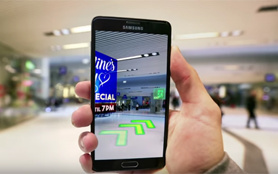Augmented reality apps based on Wikitude can now take full advantage of iOS 13 and Android 10 with SDK 8.9.
Good news: our augmented reality SDK is ready for both Android 10 and iOS 13 changes! Wikitude developers can benefit from Apple’s and Google’s OS updates as of today.
SDK 8.9 includes:
- Support for iOS 13 and Android 10
- UIWebView deprecation
- Wikitude SDK accessibility via Maven (Android only)
Support for Apple iOS 13 and Android 10
In the past weeks, our development team has been digging deep into the public beta versions of the new Android 10 and iOS 13. With the official release of Android and Apple’s new version of their OSs, we’re excited to share that SDK 8.9 is fully compatible with both operating systems.
The official release of iOS 13 last week raised lots of excitement from the developer crowd.
The new OS and ARKit updates indicate that augmented reality remains key to Apple’s strategy for the upcoming years. The video below shows what’s in for Apple and AR in 2019.
iOS 13 will be available on iPhone 6s or later versions. Here’s a full list of confirmed devices that can run Apple’s latest OS.
Android aficionados also get to enjoy the latest and greatest of Android 10 with SDK 8.9. And just because Google dropped its dessert naming scheme, it doesn’t mean we don’t have sweet news for AR devs.
Adaptive battery improvements will largely benefit the use of AR apps and recent updates on Google Play Services for AR (former ARCore) helps your app stick AR content into the world with Cloud Anchors. Also, a few additional devices will now have access to Google’s AR services.
Curious when your phone will get Android 10? Well, you might need some patience depending on the devices you work with…

Skip double coding with SMART
If you can’t wait to make your AR apps compatible with these new OSs here’s how Wikitude can make your life easier: use our SMART feature.
Seamless AR Tracking (SMART) allows you to work with ARKit and ARCore under a single API. Yes, you read that right – it means no double coding needed. Learn how this feature can save you time (and money) when building your AR apps.
UIWebView deprecation
Starting with iOS 8, Apple replaced the UIWebView component with its own WebKit-enabled WebView (WKWebView) to add web content to apps. A web view component has always been a core part of the Wikitude SDK rendering HTML content as part of our JavaScript product.
With iOS 13 changes, Apple has recently started to issue warnings to developers who try to submit an app to the App Store that includes code referencing UIWebView. This is a breaking change for iOS apps.

Given the move from the App Store team, Wikitude SDK 8.9 for iOS now ships without UIWebView, so our SDK users can easily comply with those regulations.
All customers are strongly recommended to upgrade their iOS apps to avoid any issues with Apple’s new regulation. Customers holding an active Wikitude SDK subscription are entitled to a free upgrade. If you have any questions feel free to reach out to our team.
Wikitude SDK now accessible via Maven
Updating the Wikitude SDK just became easier for Android developers. With this release, you can access the latest version of Wikitude’s technology through Maven straight from Android Studio.
If you’re just getting started with Android development, Maven is an established dependency package manager used widely in Java-based projects. Its purpose is to simplify builds of your application, especially when using third-party libraries.
Traditionally, the Wikitude SDK is available as a downloadable package, which included the actual Java libraries as .aar and .jar. With this new flow using Maven, developers will be able to update the SDK version number in one configuration file (build.gradle).
Wikitude provides files for JavaScript API, Native API, and Vuzix for now. See details on how to set up the Maven repository.
Download Wikitude SDK 8.9
Active Wikitude SDK subscribers are entitled to all SDK version updates released throughout their term. Follow the links below to update your AR SDK:
- Wikitude AR SDK for Android
- Wikitude AR SDK for iOS
- Wikitude AR SDK for Windows
- Wikitude AR SDK for Unity
- Wikitude AR SDK for Cordova
- Wikitude AR SDK for Xamarin
- Wikitude AR SDK for Flutter
New to Wikitude? Download a free Wikitude SDK 8.9 trial version for testing purposes or contact our team to discuss your upgrade possibilities.
To explore all SDK options, including smart glasses, plugins, and other dev tools, please access our download page:
Interested in creating an AR project of your own? Access our store to choose your package or contact our team to discuss your specific AR requirements.
 Support
Support FAQ
FAQ








